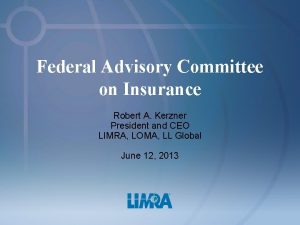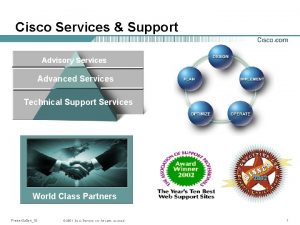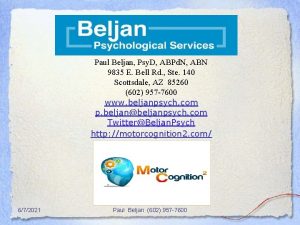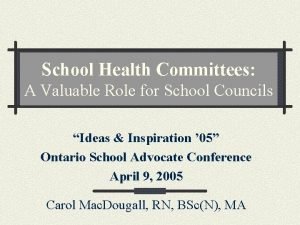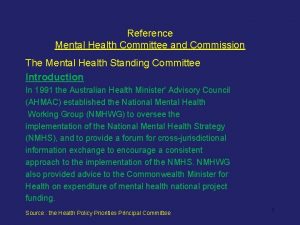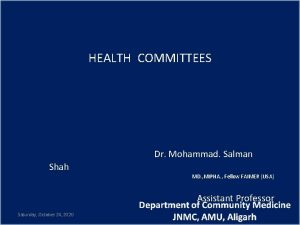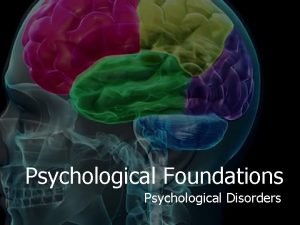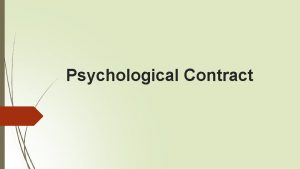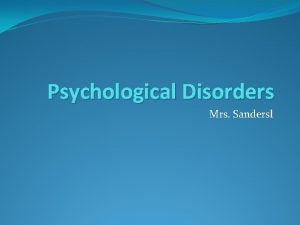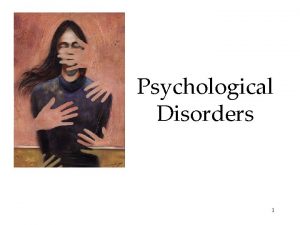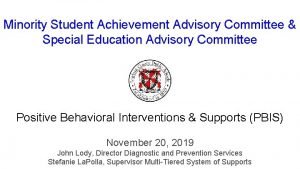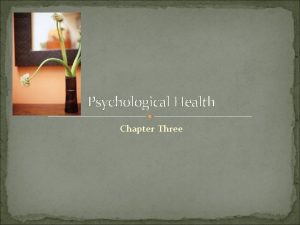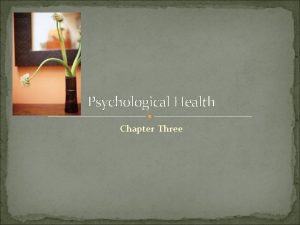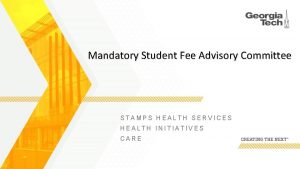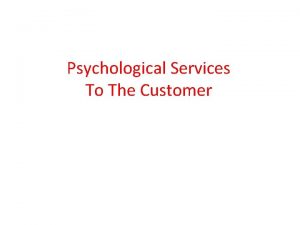STUDENT PSYCHOLOGICAL SERVICES Health Services Advisory Committee May

























- Slides: 25

STUDENT PSYCHOLOGICAL SERVICES Health Services Advisory Committee May 8, 2013 Bert Epstein

But, first a therapy cartoon…

Student Psychological Services--Outline Presentations to Campus Community � Specialized Services: � �Spanish-Language Therapy �Psychiatric Services � Therapy �Drop-In & Individual Therapy Wait List & Outcome � Consultations to Campus Community � Training Component: � �Weekly 2 -hour seminar, over 30 topics

Presentations by SPS Staff � Workshops � 8 Seminars (purposeful reduction from 19 last year) � 240 Students (projected; up from 87 last year) ○ Range = 4 – 80 � Outreach to Classrooms: � 16 Classes (down from 21 last year) � 518 Students (down from 734 last year) ○ Range = 22 - 50

Specialized Services (8/20 - 4/30) � Spanish-Speaking Therapy (10 hrs/wk) & Psychiatric Service (4 hrs/wk) 250 200 150 2011 -12 2012 -13 100 50 0 SPA Cs SPA Sess PSY Cs PSY Sess

Drop-In Appointments (8/15 -4/15) 33% increase last year over previous; 11% increase this year 300 250 200 150 100 50 0 2008 -09 2009 -10 2010 -11 2011 -12 2012 -13

Accessibility % Students requesting drop-in seen same day: 2011 -12 75% 2012 -13 (Spring Semester) 90%* ** * Shifted to having all students be seen in DI. ** About 5% not seen same day because their schedule does not permit. Other 5% not seen because too many people came in same day, and so we triage such that people with least urgent need (through careful screening) asked to return next day.

Accessibility � Average Wait time to be Seen: � 2011 -12: 5 Days � 2012 -13 (Spring Semester): 0 Days

Wait List … The Good News: � Average number students on Wait List: � 2011 -12: 50 2012 -13: 22 � Average number days from first contact to first ongoing therapy appointment (not including drop-in appointment): � 2011 -12: 62 2012 -13: 29 � Students Who Did Not Respond to Call After Being Put on Wait List: � 2011 -12: 54% 2012 -13: 24%

Wait List Disposition � After Initial Drop-In Session, when clients were put on wait list, they then were: � Seen: 58% � Referred: 9% � No Response: 24% [last year was 54%] � Declined: 8% � To be seen in summer: 2%

Outcome: Client Evaluations � “My academic performance was compromised a little in the beginning, but has improved since then. ” � “It is amazing how accomplished I feel for doing this!” � “It helped me concentrate much better in school. ”

Outcome: Client Evaluations � “I was able to work on my problems and not let them interfere with my school work (which it had been). For example: I was able to focus on school and not have my concentration break easily. ” � “As I felt better about myself, I had more energy to devote to my school work. If I hadn’t had someone to talk to, I may have dropped out of school. I was surprised how quickly I was able to recover with the help of my therapist. ”

Outcome: Client Evaluations � “I am coming back to school after 20+ years. I had a huge fear of failure. I believe therapy gave me the faith I needed to succeed. I am happy to say that I am averaging a 4. 0!” � “I was going to give up on class, but after talking with Shoshana I was better able to rationalize things and stay in class. ”

Outcome: Client Evaluations � “I was at a C or D, and now I am at an A. ” � “I am less stressed and more able to focus on what I need and feel more capable to work done for classes. ”

Outcome: GAF Scale � GAF= Global Assessment of Functioning � GAF score assigned by therapist at end of therapy � 80 -90: Absent/Minimal Symptoms 70 -80: Transient, expectable reactions 60 -70: Mild Symptoms (functioning well) 50 -60: Moderate Symptoms (moderate function) 40 -50: Serious Symptoms (serious impairment) 30 -40: Impairment in reality or in several areas 20 -30: Reality problems or can’t function in almost any area 0 -20: Suicidal or can’t take care of self � � � �

Outcome: % Improvement in GAF* 50 45 40 35 30 2011 -12 25 2012 -13 20 15 10 5 0 Minor. + 1 -5 pts � Moderate + 6 -10 pts Significant + 11 -15 pts Substantial + 16 -20 pts * Global Assessment of Functioning (GAF) change score reported by therapist at end of treatment

Outcome: CCAPS (Counseling Center Assessment of Psychological Symptoms) � This is first year of use at SPS � 62 symptom questionnaire completed by student at intake, followed by similar 34 question version at 3 rd and final session � 60 students (of 300) measured, as they received multiple CCAPS � Asks students to rate each symptom statement on a 0 -4 scale, with 0 meaning it was “not at all like me” and 4 meaning it was “extremely like me”

Outcome: CCAPS (Counseling Center Assessment of Psychological Symptoms)

Items on the Hostility Scale - Overall, intended to show not danger but frustration, irritability, tension �I have difficulty controlling my temper � I sometimes feel like breaking or smashing things � I get angry easily � I feel irritable � I am afraid I may lose control and act violently � I frequently get into arguments � I have thoughts of hurting others

Outcome: CCAPS – Change Score – first to last administration - % improvement of “reliable change” NOTE: Subscale scores deflated due to beta version 100. 00 90. 00 80. 00 70. 00 60. 00 50. 00 40. 00 30. 00 20. 00 10. 00 Depression Anxiety Social Anx. Academic Eating Hostility Alcohol Distress

Areas of Strength � Client satisfaction � Diversity of services (individual, Spanish -speaking, psychiatry, outreach) � Access – very good capability to see students immediately � Large number of students reached through classroom presentations � Robust training program and very satisfied trainees

Areas of improvement this year � Improved communication with community clinics and increased referrals -> more capacity here � Expanded “pro bono” program where therapists in the community see SRJC students for free � Improved access – almost all students seen immediately � Much shorter wait list

Areas for focus next year � Transition to new supervisors � Streamline client and therapist paperwork � Further refinement of intake/triage/wait list � Technology: Expand website & Bring on Electronic Medical Records � Further implement new, extensive Outcome Measurement system


Questions & Comments
 Nasa astrophysics advisory committee
Nasa astrophysics advisory committee Yashpal committee report 2009
Yashpal committee report 2009 Trade union advisory committee
Trade union advisory committee Federal advisory committee on insurance
Federal advisory committee on insurance Aviation rulemaking advisory committee
Aviation rulemaking advisory committee Ppp advisory
Ppp advisory Kapgrow corporate advisory services pvt. ltd.
Kapgrow corporate advisory services pvt. ltd. Deloitte financial advisory services
Deloitte financial advisory services Cisco support services
Cisco support services Financial services advisory ey
Financial services advisory ey Bia advisory services
Bia advisory services Internal auditing assurance & advisory services
Internal auditing assurance & advisory services Kpmg board of directors
Kpmg board of directors */map_uk/advisory/portfolio.nsf/frmlandingpage?openform
*/map_uk/advisory/portfolio.nsf/frmlandingpage?openform Four components of psychological health
Four components of psychological health Beljan psychological services
Beljan psychological services Kennesaw state university counseling
Kennesaw state university counseling Iapt trafford
Iapt trafford School health committee
School health committee Mental health committee
Mental health committee Bhore committee
Bhore committee Hci patterns may or may not include code for implementation
Hci patterns may or may not include code for implementation What i did last weekend essay
What i did last weekend essay What did they do last weekend
What did they do last weekend National student clearinghouse student tracker
National student clearinghouse student tracker Class maths student student1 class student string name
Class maths student student1 class student string name



